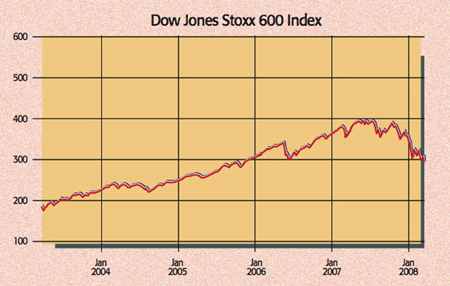
Early this month, many were optimistic about Europe’s ability to withstand global storms. The IMF expects growth of 1.6% this year after last year’s 2.6%. Unemployment fell to a 15-year low in February, and business confidence in Germany, which comprises a third of the eurozone, ticked up. In January, German exports rose by 9% year-on-year, while the increase in the eurozone’s annual industrial production growth rate to a two-month high shows that the sector is slowing but “far from collapsing”, says Capital Economics. European consumers save 14% of their income, compared to 0% in the US, providing scope for rising consumption to compensate for slower exports as global growth flags.
But the outlook is darkening. The pan-European Stoxx 600 index has hit late-2005 levels, with Germany’s Dax index down 24% this year as global jitters have intensified. The IMF this week warned Europe of the “economic damage from the financial market crisis”, while the ECB’s focus is on inflation – at a 14-year high of 3.3% – as the Fed has slashed rates and sent the euro soaring. It hit $1.59 this week, fuelling concern over the impact on exports and growth; exports comprise 20% of the eurozone economy. The longer we stay at current levels, the more damage there will be; it’s only a matter of time,” says Holger Schmieding of Bank of America.
Exports to the US fell by 8% in the last quarter of 2007. German car giant BMW slashed more than 5,000 jobs last month and warned of a sustained rise in the euro, while a February survey of eurozone purchasing managers found that growth in new export orders hit a 33-month low. According to S&P, a 10% rise in the trade-weighted euro – up by over 15% since the start of last year – reduces economic growth by 0.25%.
World growth is more important for export demand than currency moves, however; a 10% drop in world demand lowers exports by 8%. Demand looks set to dwindle as the US recession spreads to other economies, while Europe is still more exposed to the US than many realise – even though the US share of EU exports has dwindled to 12%, as Wirtschaftwoche’s Malte Fischer points out. Subsidiaries of German companies sold $352bn worth of goods in 2005, a sum four times larger than the value of exports to America. French affiliate sales were six times exports.
And what of the credit crunch? Bank lending to firms has remained strong so far. But the longer the crisis lasts, the more reluctant they will be to extend credit, says Fischer, while spreads on corporate bonds have risen sharply and issuance has slid. Banks have yet to tighten mortgage standards significantly, but households are already reining in borrowing as interest rates have risen, says UBS. In January this grew at just 6.1% year-on-year, a six-year low. “Falling consumer confidence suggests no end to this downtrend”. It also suggests that consumers may not open their wallets, despite improving labour markets; in Germany they are still “not spending enough to fuel the economy”, as Mark Landler notes in the International Herald Tribune. But the Bundesbank’s German growth estimate of 1.6% this year is partly based on consumption improving.
Other big economies also look shaky. Italy is on the brink of recession and Spain is facing a housing bust and could be moving towards recession, says Capital Economics. Given all this, it’s no wonder Schmieding reckons Europe’s economy could well stagnate this year. Goldman Sachs noted recently that the consensus is expecting growth of 8%, while it foresees an 8% decline. The downtrend in stocks looks set to endure.